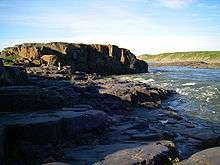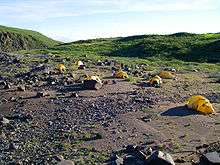Bloody Falls

Bloody Falls (or Bloody Fall, or Kogluktok, meaning "it flows rapidly" or "spurts like a cut artery" in Inuktitut)[1] is a waterfall in the Kugluk/Bloody Falls Territorial Park and is the site of the Bloody Falls Massacre and the murder of two priests by Copper Inuit Uloqsaq and Sinnisiak in 1913.[2]
The nearest hamlet, Kugluktuk, Nunavut, is 15.8 kilometres (9.8 mi) away.

Historically, this area was occupied by the Kogluktogmiut subgroup of Copper Inuit.[3]
In 1978, the portion of the Territorial Park northwest of the Coppermine River was designated the Bloody Falls National Historic Site of Canada, as the archaeological remains of pre-contact hunting and fishing sites in the area form a record of the presence of Pre-Dorset, Thule, First Nation and Inuit peoples over the last 3000 years.[4]
References
| Wikimedia Commons has media related to Bloody Falls. |
- ↑ "Bloody Fall, Nunavut, Canada". travelingluck.com. Retrieved 2008-08-25.
- ↑ Stern, Pamela (2004). Historical dictionary of the Inuit. Lanham: Scarecrow Press. p. 149. ISBN 0-8108-5058-3. Retrieved January 26, 2011.
- ↑ Stefansson, Vilhjalmur (1914). The Stefánsson-Anderson Arctic Expedition of the American Museum: Preliminary Ethnological Report. New York: The Trustees of the American Museum. p. 27. OCLC 13626409.
- ↑ Bloody Falls National Historic Site of Canada. Directory of Federal Heritage Designations. Parks Canada. Retrieved 29 October 2013.
Coordinates: 67°44′36.06″N 115°22′02.69″W / 67.7433500°N 115.3674139°W